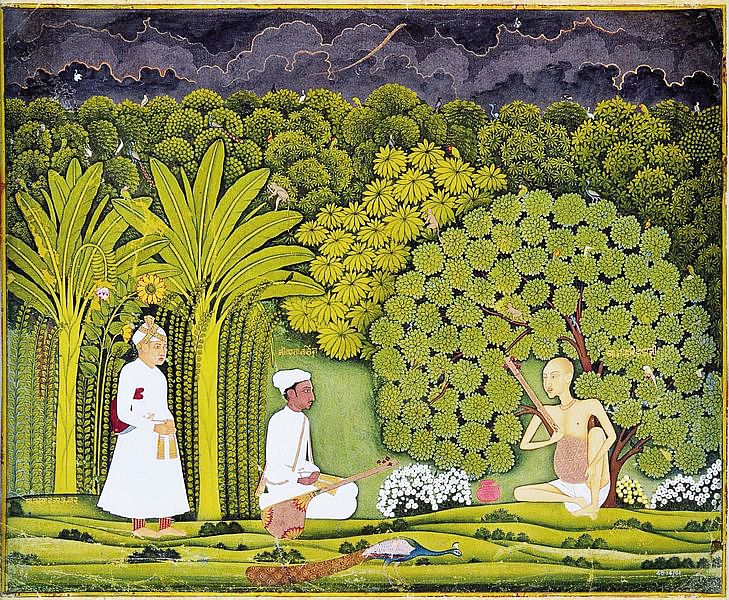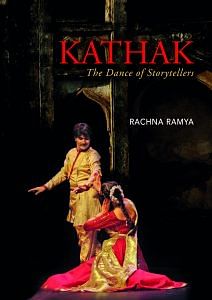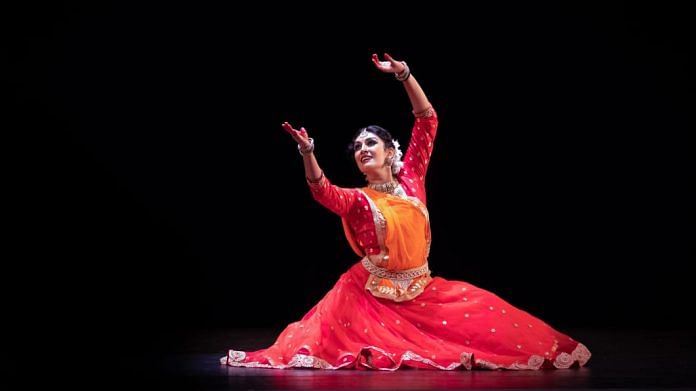The golden era of Kathak is considered to have begun under the third and, perhaps, the greatest ruler of the Mughal Dynasty, Akbar the Great (1542–1605). According to Paris Franz, ‘Akbar’s patronage of the arts was an aspect of government, in an age where cultural grandeur reinforced the regime’s legitimacy.’
Under Akbar’s patronage, the most impressive features of Hindu and Muslim traditions were amalgamated, giving birth to an integrated and sophisticated Indo- Islamic art and culture. Akbar’s library consisted of over 24,000 volumes written in Sanskrit, Persian, Greek, Latin, and Arabic. Numerous artists, poets, musicians, dancers, scholars, calligraphers, architects, painters, and craftsmen adorned his court. According to the Ain-i-Akbari, a sixteenth- century detailed document written
by Abu’l-Fazl ibn Mubarak, there was a famous Kathak dancer in his court known as Vallabhdas.
After Akbar, his son Emperor Jahangir (1569–1627) became known for his patronage of arts. During his rule, a unique style of Mughal miniature painting developed and thrived. Jahangir himself was an artist and owned an atelier. Mughal miniature painting is characterized by attention to small details—geometrical and intricate patterns, lush tones and colours, epic subject matter, strong, linear, two-dimensional perspective, great energy, and a romantic portrayal of nature. These characteristics can be observed in all North Indian art forms of that time, including Kathak. Kathak also developed as a linear dance form as opposed to other circular Indian classical dance styles. Just like the miniature paintings of that time, Kathak also depicted stories in a romanticized manner with great energy and vitality.

The seventeenth century witnessed the rule of Jahangir’s son—Emperor Shah Jahan (1592–1666)—who is known for his love for architecture. Shah Jahan built many prominent monuments, among which the magnificent Taj Mahal stands out as one of the finest structures of Mughal dynasty. The unique design patterns of the Mughal miniature paintings can be seen in the decorative elements of Taj Mahal. These decorative, intricate, and vibrant designs can be witnessed in all North Indian art forms that were inspired by the Indo- Persian influences, whether it be the fine arts such as dance, music, painting, and poetry, or the craftsmanship in architectural structures, ornamental carpets, brilliantly decorated utensils, fine jewellery designs, Kashmiri woodwork, and tapestries. The designs created by the artists of this time were geometrical in nature.
A great contribution has been made by the Moghals to the art of India, and that in the art of geometrical designs and patterns in every branch….This art of geometrical designs may be explained in the way that more of finer and nicer designs and patterns within patterns, and the designs within designs, very often most intricate ones, were introduced in every art, so much so that no space in broad structure were allowed. These geometrical designs made the art more beautiful and attractive….The modern system of Kathak in which more of intricate time measurements are shown, is obviously the product of this Indo-Persian cultural fusion. There are doubles, four times, eight times, and more and more speed with every kind of fractional measurements.
However, after the reign of Shah Jahan, Kathak and other North Indian art forms experienced a significant decline in their development and expansion. Shah Jahan’s son Aurangzeb (1618–1707) fervently opposed the practice of arts. He was an orthodox Muslim and discarded his grandfather Akbar’s ideas of secularism.
It is reported that Aurangzeb ordered the burial of all musical instruments and banned painters and paintings. During his time, Kathak dancers went back to their rural homes and villages in hiding. They were treated as social outcasts. During Aurangzeb’s reign, arts did not receive royal encouragement or royal patronage. Nevertheless, a painting in gouache is in existence from his time in which two girls are dancing Kathak. At present, this painting is located at the Musée de l’Orangerie in Paris, France. On 21 March 1995, the United Kingdom issued a stamp of this painting in a booklet form with nine other stamps in the series.
Many traditionalists assume that tradition opposes and resists experimentation. In the case of North Indian music and dance, this presumption does not hold true. During the Mughal period, Kathak proved its progressive penchant by adopting new movement vocabulary and disposition of Mughal arts while still keeping the integrity of its pedigree. In this era, the main elements and characteristics of Kathak dance were developed. The use of footwork, spins, intricate rhythmic displays, and angular movements became the signature trademark of Kathak. The devotional Kathak dancers of temples became the entertainers in Mughal courts with lavish costumes, refined movement and rhythmic vocabulary, extraordinary aesthetics, improvisational aptitude, and technical genius. Kathak became a sensual art form, which leaned towards romanticism and, therefore, shifted its disposition of being a temple dance to a court dance.
During the period of Bhakti Movement, there was more emphasis on the emotional aspects of dance. Kathak became more of an art to display in the Mughal era. The lavish and grand environment of the Mughal courts attracted the artists of that time, where their attention turned to please the emperors and courtiers in order to receive expensive gifts, favours, and fame. Nayika-bhed, which is an archetypal classification of the romantic heroines and their relationship with the nayaks or the heroes, became a favourite subject to portray in dance for Kathak dancers. New vocabularies such as ched-chad and kasak-masak were developed to create suggestive sentiments and gestures. The passion and erotic elements became more dominant in Kathak. Notably, there were also Kathak dancers during this time who avoided the seduction of the luxurious lifestyle of the Mughal courts. They continued to practice the art of Kathak in its purest and unadulterated form. This is why, today, Kathak has retained both its traditional beauty and the Mughal era’s progressive passion, making itself a complete dance form.
 This excerpt from Kathak: The Dance of Storytellers has been published with permission from Niyogi Books.
This excerpt from Kathak: The Dance of Storytellers has been published with permission from Niyogi Books.




Muslim invaders debased hindustani music and kathak to satisfy their ego, glory and entertainment. Otherwise indian arts are dedicated in praise of god
Print has great future to get funds from pakistan, iran, turkey,
Don’t distort history. The Akbar was a rapist and his sole motive was enjoy women. Golden era of Indian classics ended with fall of Indian rajas. Our temples carried the tradition of dance, drama, architect, fine arts to their highest form. It’s decline started with Muslim rulers specially Mughals.
What Golden era? Leaving socially respected status of temple dancers and becoming part of concubinage is golden era? Please read the history to understand status of temple dancers of various dance status prior to islamic invasions and destruction of temples & related various parts of ecosystems. Please read how indepensent temple artists were forced to live a life for entertaining mughals & their darbars. And if patronage in the form of concubinage to few dancers is golden era then what one should call the era when Natyashastras were actually developed & nurtured?
What Golden era? Please read history to understand the freedom & the social respect the temple dancers enjoyed before islamic invasions. Post destruction of temples, arts and in Mughal era they formed concubinage of mughal emperors & nobles. You call this golden era? What you would call to the era when actually these art forms were conceived, nurtured & developed and when Natyashastras were written?
Nowdays your media pleasing mugal emperor to cover up their curlity made to Hinduism
Please also read Akbarnama. Akbar was a blatant sex fiend and addict from his teens. He regularly used to send his favored on Ghazi missions to loot and convert people in outlying villages. He had one of the biggest brothels in history. He had young pre puberty boys and girls for his pleasure. Mughals if at all only made the ethnic dance forms more decadent and reliant on its courts largesse as they destroyed the very fabric of Hindu tradition which celebrated dance and many other art forms as part of its socio cultural system.
Great article. Emperor Akbar was what one would describe as a ‘boundary-less’ leader in management jargon. He was a true immigrant who gave his soul to his adopted country. Unfortunately, his liberalism was replaced by extreme right-wing, islamist ideology followed by his great-grandson. Akbar’s positive legacy is as much worthy of discussion as that of the Mauryan Kings, notably The Great Emperor Ashoka.